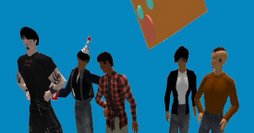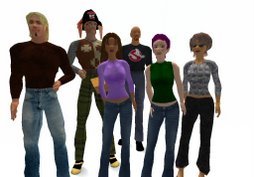In the project overview, it says we will work with our teachers to "document the educational value of using Second Life as a digital media tool in and out of the classroom" and "develop a collaborative build that utilizes the unique qualities if the 3D medium".
We’ve been working on this Second Life experiment for two months. We’ve learned how to build objects and learned how to cooperate online without face to face real life communication. We have some experience now and it is time to develop our understanding of this medium. Some of us seem to have an intuitive understanding. I think it is time to put it into words. What is the future of this program as a learning tool? What is the future of Second Life?
Over this spring break, these were some of the questions that entered my mind. In 8 weeks, our team will have to present a proposal for next year’s students. But before we do this, we must ask ourselves to define exactly how Second Life is a useful tool for teaching and learning.
Analyzing the different ways we communicate with each of these tools while we compare online media may provide some in-depth answers. I think some of the online communication we learned to do in Second Life can also be done in other media, such as blogs and forums. 3-D design can also be done with Google SketchUp for example. Exactly how are these tools different from each other? How are some of these tools better than others for certain things?
Some claim Second Life might be the successor to the traditional internet browser, or add to the 2-D experience. However, I need to develop my understanding of the benefits of a 3-D environment when it comes to researching online. There certainly seem to be disadvantages to using SL for some things.
Of course, you could see how many other people are looking at the site, but I’m sure many would find that inconvenient. Since Second Life uses the basic laws of physics, the more people there are at an area, the further away some people will have to be, making their online experience a nuisance. In other words, if there are 50 people at the same site, some people will not be able to view the site properly, because of perspective issues.
Second Life seems like it could be a useful educational tool. I want to understand what makes it useful and why some experts believe it is a glimpse into the future of learning. We need to continue this discussion together and include experienced SL students from other communities. We should be able to identify the qualities and benefits of this new medium that distinguish it from other media.
On a light note, check out this mock video. How far should we extend ourselves with online communication? Is there a limit? I look forward to responses from DAA students and people outside our school.


7 comments:
Haha. Nice video. It does show the redundancy of Second Life. On the other hand, I think that Second Life does have potential, especially for education.
Haha love the video. I think u brought up a lot of good arguments against Second Life but there is so much good and so little bad that one cannot diregard it easily. I just wanted to point that out. I think our next project should be makin a video like that...just with all of us and much funnier!
This post is valuable because this is the first time we are questioning the promise that Second Life holds. In some ways this is good because it will help us figure out what aspects of SL we should focus on to get the maximum benefits from the medium--And the video was just hilarious!
Its true that SL can't replace the internet. But then again its not designed to. SL is an alternate means of communication. A medium that allows people from all around the world to gather together in a virtual world so they can communicate much like in real life. Its a cross between cultures much like DAA.
Though it does have its drawbacks like the ones you've mentioned. It also lags a lot. It isn't very user friendly, the introduction is vague and not too helpful. It also requires a good deal of time and effort to learn to build and script...
Nice video... i totally agree with your thoughts on Second Life.
Very important questions have been raised! I think one great advantage of Second Life is the ability it provides us to very easily access niche groups for their expertise when needed. (Social networking)
Henry Jenkins has some thoughts on social networking for educational benefit in his casual paper titled, "Confronting Participatory Culture: Challenges for the 21st Century". I will select some readings from it for next week.
I suggest doing the following to find answers to your questions:
1. Social networking in SL to find multiple people or a group with educational experience/expertise in Teen SL. Global Kids is a great place to start. Spend as much time integrating with that community as possible.
2. Seeking input on our blog should help as well. I suggest visiting the blogs at Suffern MS and PacRimX. You can comment there and invite them to comment to our blog as well. Get involved!
3. I will assign a selection of readings on the Moodle course to help explore these issues and questions with you. The first reading will be about Marshall McLuhan's definition of a medium and his 4 Laws of Media.I have posted 3 questions and a short written assignment to be posted on the Moodle course.
Great questions, timely and necessary. Keep up the great work and have fun exploring for the answers!
Alpine
Wow, Second Life does emerge in a educational way as it is a good learning technique. I agree 100%! good job.
Dre
Post a Comment